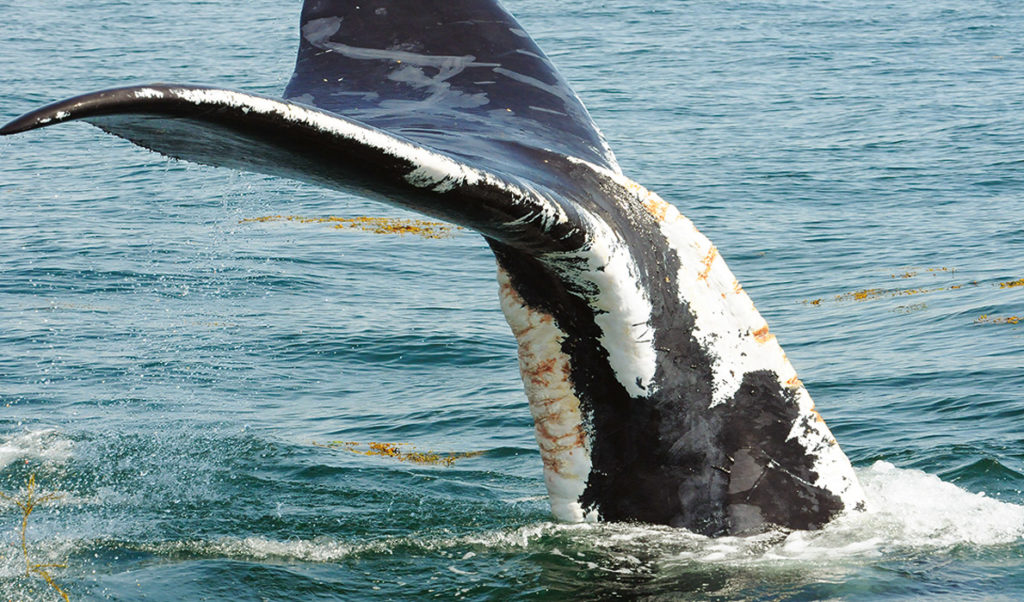When I was a child, I listened to Smoky Bear tell us, “Only YOU can prevent forest fires!” That was a clear and direct message but it was wrong. This summer, vast regions of North America were on fire and most of those fires started from lightning strikes, but the expansive tinder-dry conditions fueling the fires resulted primarily from climate change.
Closer to home, we learn that the North Atlantic right whale is on the brink of extinction. That is serious and shocking, but from my perspective, current explanations are wanting.
NOAA Fisheries states that these whales are “dying faster than they can reproduce, largely due to human causes…” It identifies those causes as “vessel strikes and entanglements.” This leads many to think the lobster fishery can prevent right whale extinction.
Right whale called calves peaked at 39 in 2009 but declined to zero by 2018.
As a professor in the University of Maine’s School of Marine Sciences, I teach students they must first determine patterns of distribution and abundance and then consider which factors are most consistent with, or most likely causing those patterns. When I apply that approach to the right whale and the lobster fishery, the patterns and timelines don’t seem to fit.
The latest information on the NOAA Fisheries website notes that in 1990, fewer than 270 North Atlantic right whales existed but their abundance steadily increased to a peak of 480 in 2010. They then declined steeply to the current 340.
During the 20-year population increase, lobster trap tags issued in Maine (for each trap, associated lines, and buoys) increased from 2 million to 3.5 million, peaking in 2005, ten years before the right whale population started to decline. Similarly, NOAA’s “cause of death data” shows a decline in vessel strikes.
So, what corresponds with the population decline? Let’s consider trends in birth rates and death rates.
Right whale calves peaked at 39 in 2009 but declined to zero by 2018. The consequence of no offspring is obvious. However, since then, 64 calves have been born and only 16 whale deaths have been documented. NOAA’s causes of 36 deaths from 2017 to 2023 shows 12 from vessel strikes and nine from entanglement, with most of those in Canada. While those sources of death are likely under-counted, they do not account for the decline of 140 whales since 2010.

Right whales got their name because they were slow swimmers that float when dead, perfect for 18th century whalers. Some hypothesize dead whales are sinking and that explains underestimating mortality rates.
Admittedly, Maine’s lobster fishery has more vertical lines in the ocean than any other area or any other fishery. Although entangled right whales have rarely been seen in the Gulf of Maine, researchers have seen entanglement scars and speculate that repeated entanglement with fishing gear happens and it is so stressful that they deplete their blubber reserves, fail to reproduce, and when they die, they sink. NOAA estimates about three whales die for each identifiable death (called cryptic mortality).
So, if trends in lobster fishing gear do not correspond to population decline, then what does? Nutrition, in the form of the planktonic food right whales eat. Calves started to decline in 2010, the year Gulf of Maine oceanography changed, according to a scientific publication.
Climate change shifts the Gulf Stream closer to the Gulf of Maine. Starting in 2010, warm salty tropical water started entering the Gulf of Maine, also blocking the cool nutrient rich water from the Labrador current. This spelled trouble for cold water zooplankton such as Calanus finmarchicus, (the whale’s most important food). Without Calanus, right whale nutrition was compromised and likely contributed to the declining calving rate.
The study also showed right whales leaving the Gulf of Maine for cooler Canadian waters, possibly reconnecting with their favorite food resulting in calving increases since 2018.
This leaves us with the unsettling notion that even if all lobster traps were removed from the Gulf of Maine, North Atlantic right whale populations may fluctuate as an indirect effect of climate change.
If so, perhaps in the long run Smokey Bear was right to say, “Only you can prevent forest fires.” Only by reducing greenhouse gas emissions globally will we eventually see climate-driven ocean currents, zooplankton, and the lobsters and whales that depend on them return to the Gulf of Maine. I just hope the whales can hold on until then.
Bob Steneck is a professor at the University of Maine School of Marine Sciences and a Pew Fellow in Marine Conservation.





